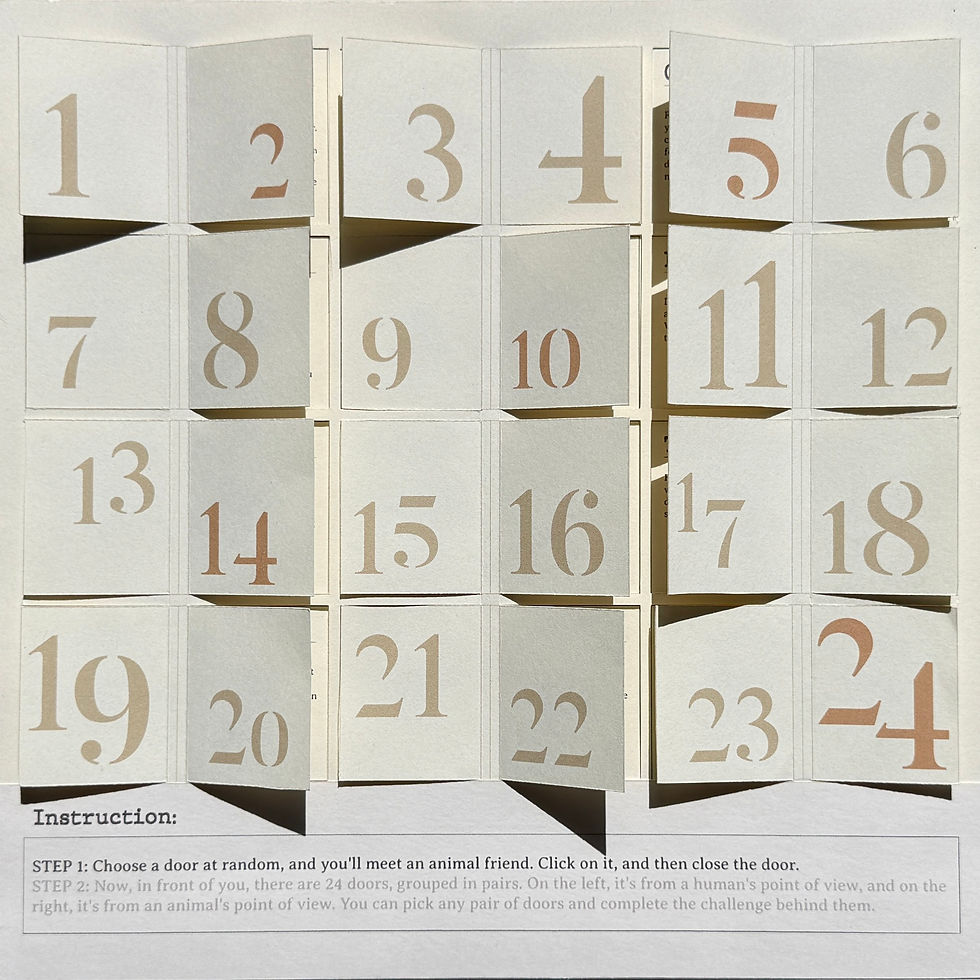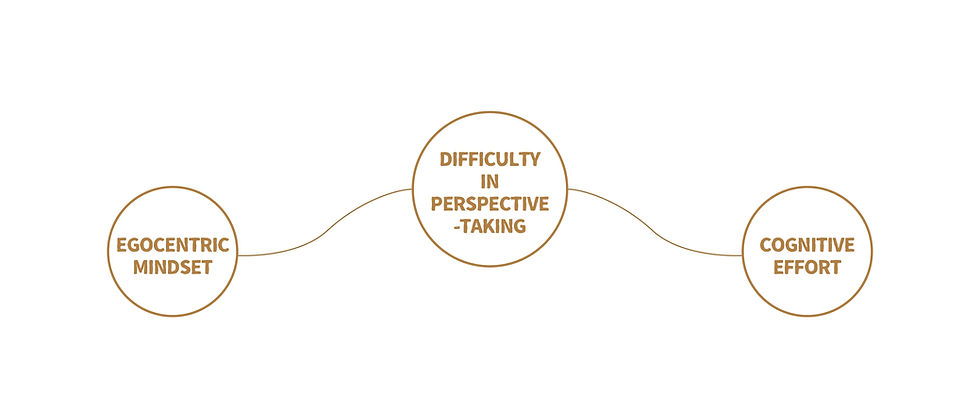
Empathy Advent Calendar
An interactive educational tool at the core of a teaching project that helps beginner design students develop empathy and user perspective through an eco-centric approach.
Educational Tool
Pedagogy
Eco-centric Design
Design Thinking
Overview
This teaching project was designed for beginner design students transitioning from purely artistic self-expression to the practice of design.
At this early stage, even the idea of a “user” is new to them. To help students develop empathy and perspective-taking skills without defaulting to subjective assumptions, the project introduces non-human beings, such as animals and plants, as the first “users” they learn to design for.
By starting with a broader, eco-centric view rather than a strictly human-centered one, students build flexible thinking and multi-sensory awareness from the very beginning of their design education.
About the Tool
To make empathy training playful and tangible, I designed the Empathy Advent Calendar, an interactive educational tool at the heart of the project. It provides a structured and engaging way for students to explore empathy by practicing with non-human users.
The device contains 24 paired doors, each linked to a challenge:
ROUND 1: Students first open a random door to meet an animal friend. This animal becomes the focus of their empathy practice.
ROUND 2: They then work with paired doors: the left door prompts them to think and act as a human, while the right door challenges them to take the perspective of their animal friend.
This dual-structured experience follows the process of understanding user needs, but with a radically expanded definition of what a “user” can be. As students shift between human and non-human viewpoints, they practice perspective-taking and begin to notice senses they often overlook, including touch, sound, and movement, rather than relying only on sight.
01


ROUND 1: Choose a door at random, and you'll meet an animal friend. Click on it, and then close the door.
02


ROUND 2: Now, in front of you, there are 24 doors, grouped in pairs. On the left, it's from a human's point of view, and on the right, it's from an animal's point of view. You can pick any pair of doors and complete the challenge behind them.

The 24 animal friends

Prompts for the sea anemone, shown as an example
Design Concept
Empathy: through the lens of ecocentric design
Learner Characteristics

Learners are a group of beginners learning user experience design, and generally have art backgrounds before enrolling.
Guiding Questions
01
How does the animals' experience differ from yours?
02
What do your animal clients want?
Learning Problem

Learners are accustomed to expressing themselves through art and believe that, as designers, the greatest value lies in conveying their unique perspective on problem-solving. As a result, they often fall into a designer-centered mindset. Most learners understand the importance of empathy, but often skip taking concrete actions to understand user needs due to the difficulty in perspective-taking.
Learning Outcome
After engaging with this educational tool, learners will be able to:
01
Students will be able to know how to perceive like an animal.
02
Students will be able to observe and research animal behaviors to imagine how that beings experience the world around them.
03
Students will be able to foster an awareness of empathy and understand its significance.
They will also have the capability to know how to intentionally think with empathy during the design thinking process.
Evaluation Plan
01
Empathic Observation:
Indicator: The ability to observe and describe an animal's behavior, emotions, and needs.
Assessment: Learners need to prepare presentations based on their observations of animals. Each learner can create a brief presentation summarizing their findings.
02
Self-Reflection and Empathy Growth:
Indicator: Self-awareness and reflection on empathy growth in empathy towards animals.
Assessment: Learners need to keep journals or reflections about their evolving understanding and empathy for animals over the course of their studies.
Cognitive Activities
01
Introduction
Lecture on the concept of empathy: Introducing the importance of empathy through a comparison of designer-centered and user-centered cases, such as designing a garden from the perspective of a bee versus a human.
02
Engage with the Empathy Advent Calendar
Practice with the Empathy Advent Calendar to complete challenges.
03
Documentation
Document your attempts and feelings using videos, images, texts, collages, etc.
04
Reflection
Write, edit, or record your takeaways and reflections on Medium, share the link on Slack and actively engage by leaving comments and joining discussions.
Classroom Testing

Classroom testing confirmed that the tool effectively engaged students and revealed clear improvements in their empathy and perspective-taking skills.
Teaching Philosophy

Adaptability

Keen Perception

Turn Weaknesses into Strengths

Interest-Driven
My teaching philosophy for cultivating creative confidence and creative self-efficacy centers around the key affordances of Adaptability, Keen Perception and Turning Weaknesses into Strengths.
Adaptability: In my approach to teaching and learning, I recognize that each student possesses a unique set of characteristics and misconceptions about creativity. To effectively nurture their creative confidence, I adapt my guidance to their individual needs. By addressing their specific challenges and correcting negative beliefs, I aim to empower them on their creative journey.
Keen Perception: I understand that students may not always articulate their confusion accurately. To bridge this gap, I employ keen perception by observing them from various angles. This enables me to identify their true needs, even when they might not express them explicitly. This approach ensures that my guidance is finely tuned to their evolving requirements.
Turning Weaknesses into Strengths: When teaching students to confront and combat misconceptions about creativity, I believe in guiding them to shift their perspective on their weaknesses. Instead of viewing their shortcomings as obstacles, I encourage them to see these as opportunities for growth. By helping them transform weaknesses into strengths, I empower them to unlock their full creative potential.
My teaching philosophy is grounded in the belief that creativity can be nurtured through tailored guidance, perceptive observation, and the transformation of weaknesses into strengths. It is my purpose as an educator to create an environment where students can overcome barriers and discover the boundless possibilities within their creative selves.
Learning Science Topics
01
Self-efficacy
When engaging with the educational tool, learners need to embrace challenges and consistently compare the perspectives of humans and animals. For various tasks, they have to independently devise plans and steps to complete them. They also need to document what they've learned and share it with their peers, seeking process/effort feedback.
02
Motivation in Learning
These students are beginners in the field of user experience design, and they all come from art backgrounds. To kindle their enthusiasm and motivation, I've centered the topic around 'empathizing with animals' since it's a subject that can better engage their imagination and perceptual abilities compared to topics related to humans. I've designed some crazy and fun prompts to immerse them in experiencing the power of empathy.
03
Cross-Disciplinary Learning
If students are highly engaged in the course, they could develop a objective comprehension of animal needs through the study of biology.